Excitement about Mardi Gras begins bubbling up around here as soon as Christmas Day has passed. Red and green decorations quickly give way to those of purple, green and gold. Flags, banners, wreaths, twinkling lights- all manner of bling, metallic and glittery, washes over the town. Some folks even plant yellow and purple flowers in their yards. It isn’t very long after the Christmas trees get hauled away that the City starts putting metal barriers up along the parade route, narrowing already congested major roads to just two lanes. The season starts on Twelfth Night, and culminates on Mardi Gras.
I’ve tried to learn what I can about it since we relocated here, as the tradition of Mardi Gras, and frankly, anything religious, was quite foreign to me. My sense is that there are Pagan roots to all of this, which were layered over with Christianity (as were all original holidays, right?). It seems there are those who identify as practicing Catholic and follow the full protocol, those who dip in to partake of the festive parts, and those without spiritual leanings, who just enjoy a good party.
Come February, folks from all of these walks of life and more pour out of the woodwork, and many visitors come in from out of town. Lafayette more than doubles in size. This is great for gigging musicians. Bars burst at the seams even more than usual, as the local music scene goes from the normal level of “amazing” to “off the charts.” To be sure, Mardi Gras is a season, not a day, and is by far the most widely celebrated occasion here in South Louisiana.
Acadiana, the area where we live, consists of twenty two parishes that celebrate a rich history, much larger in scope than this piece of writing can cover in very much detail. But the gist of it is that in the mid-1700s, during le Grand Dérangement, settlers of French descent who were living alongside indigenous people in Acadie (modern day Nova Scotia), were exiled by the invading Brittish when they refused to convert from Catholicism, and would not pick up arms to fight for them.
Louisiana, which was under Spanish rule at the time, wound up becoming home to many of these displaced Acadians, or Cajuns, as they came to be called. Some of the traditions being upheld here today come through an unbroken lineage that dates back to these times. It’s quite remarkable. I have friends whose ancestors were among the first refugees that resettled here, that still live on the same land today.
Most people associate Mardi Gras with New Orleans, and two hours away here in Lafayette, there are parades and celebrations in the same vein. But the real story- the one unique to this interesting Acadian history, happens in the outlying countryside. In particular, on the Cajun Prairie.
We’ve been living in Lafayette now for about 18 months, having transplanted from Alaska, and I’m still learning about the complex history of this place. So please forgive me if I get anything wrong!
Lafayette is the biggest city in Acadiana, with roughly 122,000 people. It’s a lively college town that holds with the basic attitude that any occasion at all is worth celebrating. If there’s even a remote reason to raise a glass, the folks here are always ready to party.
Surrounding Lafayette are many smaller towns in parishes that boast expansive rice paddies, acres of sweet potatoes, crawfish ponds and sugarcane fields. Herons, Egrets, Spoonbills, and other Pterodactyl-like species of birds swoop around in great flocks. Enormous, centennial oak trees punctuate the otherwise flat landscape of the sprawling wetlands that spread out around the largest swamp in North America (the Atchafalaya Basin).
It’s not Alaska, and while I dearly miss the epic scenery of home, I do recognize that this place has a different kind of beauty, all its own. It’s a mood, and quite romantic, in a spooky sort of way. There’s something Sleepy Hallowish in the way low-hanging Spanish moss dangles from trees, trailing into standing water, and the stillness of thick fog suspends itself, ghost-like, around the cypress.
Here, just about thirty five miles from “the third coast,” we specialize in the aforementioned crops, dramatic weather, insect populations that beat-all, and music that is completely unique to the area. The way of life here was born from a melting pot of influences; peoples of French, German, Scotch-Irish, Spanish, Native American and West African descent have each taken a turn at leaving their marks, individually and collectively bringing forth rich traditions that remain alive and well, and have come together to shape Creole and Cajun culture into what it is today.
These are French speaking communities, where many households are still at least bi-lingual. The public radio, many of the street signs, the airport announcements and the music are all in French. The music! This has morphed into some interesting configurations through such a variety of influences, and centers around fiddles, accordions, and the t’fer (“little iron,” or triangle, traditionally made of hay rake tines).
Mardi Gras, the rowdy Catholic tradition also known as ‘Fat Tuesday,’ evolved out of the fact that what directly follows is Ash Wednesday, and the much more solemn Lenten season of forty days of repentance. Between Ash Wednesday and Easter Sunday, practicing Catholics mark the occasion by abstaining from certain indulgences. Historically, this self-denial was to commemorate the forty days Jesus spent fasting in the desert.
Modern day folks that are making a go at it might mark the occasion by setting alcohol aside, or attempting to break other destructive habits. But here in the swamp, we’re pretty far from anything resembling a desert. There’s really nothing dry about this place, literally or figuratively. So I’m not sure how well folks’ attempts at piety or sobriety have been working out in these first few days of Lent. The drive-through daiquiri stands look as busy as ever.
And while renunciation is fine and all, first, there’s Party Gras. I guess the very idea of abstaining from guilty pleasures for forty days of Lent means that for at least the forty days leading up to it, big times are called for. This helps make up for lost time in advance.
From inside my house, which is just one block from the parade route, I can hear the party raging day and night. I have been unwell, and on doctor’s orders to avoid germs, and therefore indoor crowds, in anticipation of a big surgery I have coming up on February 26th. As a result I’ve been fairly holed up, and not exactly in party rage-mode.
Living so close to it all, and at the edge of a field that becomes a makeshift parking lot for these two weeks or more, I’ve been wondering: Is there really all that much to scream about? I pick up garbage strewn all over the yard by people who have parked their cars on the grass in front our house. Spectators stake out their spots along major streets, sitting for hours ahead of starting time in folding chairs, only feet away from speeding traffic. It doesn’t look all that fun to me, but maybe I’m just not eating enough King Cake or drinking enough bourbon at ten in the morning.
What Mardi Gras means in my neighborhood is tailgate parties that go on for hours, obnoxious, canned music blaring while everyone waits for the parades to start, and people getting drunker by the hour. Then, deafening marching bands and screaming. So much screaming!
After the festivarians retire to sleep it off, one million plastic bags blow into our yard, each one stamped “Made in China.” Plastic packaging from the plastic beads people buy to throw around during the plastic parades. I can’t say I’m a fan.
To escape all of this, we don our homemade costumes and head out to the little town of Eunice, where we participate in a different, more homespun kind of madness: Cajun Mardi Gras.
This event bears no resemblance to New Orleans-style parade mania. There are no plastic beads, no floats, no parades. This is another world, and other-worldly. Le Courir de Mardi Gras, the Mardi Gras run (and no, it’s not a 5K) is a six hour romp through the countryside on foot and horseback, that begins early in the morning.
There are four big rules for this epic gathering:
1. No spectators- you must participate.
2. Costumes, including head coverings and masks that completely obscure the identity of the participants must be worn.
3. DO NOT drop trash on the ground.
4. NO beads!
Most people wear tall hats called capuchons, and homemade costumes made of shaggy strips of fabric like rags. The day consists of marauding the countryside, walking from house to house through the prairie to beg for ingredients for a gumbo, then gathering back at the starting point to eat and celebrate with a live band, take a dunk in the pond, and generally revel.
This year, as designed, there were about 800 participants and zero spectators. Each small town has it’s own run, but the particular event that we attend, Faquetaique Courir de Mardi Gras, is put on by friends. This run was celebrating its 19th anniversary, but the tradition is much, much older than that. It’s rooted in French peasant culture of medieval times. The costumes are a mimicry of the aristocracy (for the pointy capuchons, think: princess hats). Again, the idea seems to be that if one is to give up bad behavior for forty days, first, one must live it up big.
The traditional practice of concealing one’s identity on Mardi Gras could be done in order to get away with mischief, but it could also relate to beliefs from earlier times that disguises offered protection from evil spirits that roamed the earth. I’ve heard both theories. Either way, there’s an eerie magic in the morning when everyone first comes together, unsure of who’s who, some still quite drunk from the night before (Lundi Gras) and not having slept. It’s dreamlike. A surreal, collective dream you don’t wake up from.
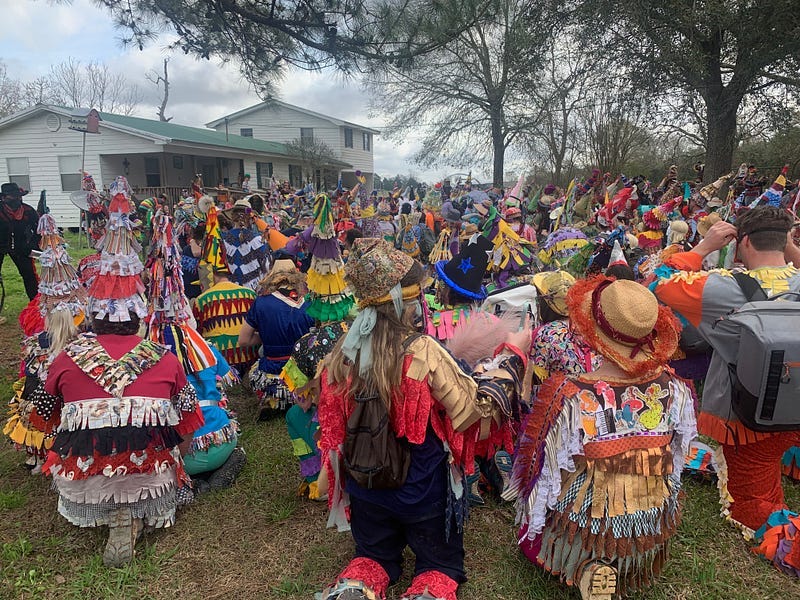
In a mile-long procession, les Mardi Gras, le Capitaine, et les Villains, la Force all travel, most on foot, some on horseback, stopping at each house to beg ingredients for a gumbo. To earn donations, the Mardi Gras play music, dance and sing. Neighbors give out potatoes, rice, or live chickens as rewards. They hand the birds to le Capitaine, who tosses them to the crowd. These get chased down by hundreds of people, and the antics are ridiculous. I can’t say no chickens are harmed in the making of this next-dimension Fun. Alas. Into the gumbo they go, as that’s just their lot in life.
In addition to such madness as chicken chasing, this a day when a free pass is given to those who might have a score to settle with someone. In that event, there could be a minor mauling or spontaneous mud wrestling (I can think of no worse place to be rolled than in a Louisiana ditch. Yuck!). As people here say, it’s “all kinna” drunken mayhem. One of my favorite parts of the day, though, is the greased pole.
Midway through the run in a big open field, there’s a flag pole covered with cooking grease. Perched inside a cage at the top is a live chicken. Here, everyone stops to take a break, and some get involved with trying to climb the pole to free the chicken. This is a group effort, and last year, my husband threw himself into the fray.
A less-than-organized human pyramid of sorts is organically formed to help someone get to the chicken. This goes on for quite a while, until finally, one person can get high enough to pull the cord and release the trap door. I’ve learned that this particular part of the days theatrics represents society. There are those who work to support others, and those few that reach the top by standing on the backs of many. My husband provided one of these backs, and was only minorly injured. His ribs, not quite cracked, his head and shoulders not too worse for wear for having been stood upon. Personally, I enjoy watching from more of a distance.
There is a heirarchy, a method to the madness. Aside from the crowd at large, le Capitaine in his purple cape leads the charge, maskless, on horseback, signalling when it’s ok to approach the next house, and there are les Villains. These people are intimidating, dressed in red and black, and carrying burlap whips. They aren’t afraid to use them, either. Les Villains are charged with preventing devolution into all-out anarchy. Their main task is to keep everyone in line. Keep moving Mardi Gras! Allez! Step it up. Put your mask back on, Mardi Gras! Other duties include dousing the crowd with whiskey.
Toward the end of the run, everyone assembles at a graveyard. Here, all the rowdy-chowdies settle into place, and an unexpected silence comes over the crowd. Respectfully seated on hallowed ground, a more solemn part of the experience is shared.
Le Capitaine, a role played by a man who is a proud culture bearer here in Acadiana, speaks of the dead with reverence, reminding us that we walk across the bones of our ancestors. The dirt is where we’re all ultimately headed, he says. It’s a good reminder to live fully while we still have hearts beating in our chests, and to make something of out of our lives that will outlast us. To dedicate ourselves to keeping traditions going for future generations. To put what’s important front and center, to keep alive in all that we do that which matters most: Love. Music. Friendship. Tradition. Always tradition.
Haunting songs are played at the gravesites of significant Cajun ancestors who gave so much to the music with their lives. Emotion runs raw, funny moments punctuate the sudden stillness as hundreds pause to hold their tongues, rest their feet, and sit atop the dust of ones who have gone on.
This year, with me being a bit down for the count, health-wise, we didn’t participate fully in the run. Rather, we went and hung out where the gumbo was being prepared, and spent time with the host family whose land, theirs for eight generations, is ground zero for the event. We played music, sang our guts out, visited with friends, new and old, and mingled with the hordes of Mardi Gras returning from their run.
Arriving back in Lafayette in the last light of a setting sun, our hearts were full, our minds, swimming with all the sights. As we entered our neighborhood, picking our way home through closed streets and parade waste, I felt so thankful to be a part of the Other-World — the one that doesn’t come wrapped in plastic, but is born of creativity, big hearts and free spirits, and dedication to such a unique tradition.
The next day, I drive across town to the woods where I walk my dogs. The crowds are gone, but trees hang heavy with strands of purple, green and gold beads. They drape over power lines and fences, and lie scattered and broken all over the ground. But that’s not all. Fast food wrappers, empty bottles of booze, so many beer cans, and other lovely signs of humans getting sloppy- like dirty baby diapers- litter the streets and fields. Trash Wednesday, I decide to call it, as the car plows through ankle-deep garbage along the one available lane.
On my way home I pass city workers loading parade barriers into the backs of trucks, reopening the roads. People I assume have been assigned community service by the justice system wear orange and walk alongside with big plastic bags, picking up trash. Running through it all with headphones on is a jogger who must be out working off his bad habits. His red sweatshirt reads, “Not today, Satan.”
Here is a video that’s already circulating on YouTube from last Tuesday. Le Mardi Gras gather at a neighbor’s house to sing and perform for their donation.
And here is the famous Mardi Gras song, La danse de Mardi Gras, the lyrics of which the day basically enacts.
English translation for La danse de Mardi Gras:
The Mardi Gras come from all around, all around the center of town.
They come by once per year, asking for charity.
Sometimes it’s a sweet potato, a sweet potato or pork rinds.
The Mardi Gras are on a great journey, all around the center of town.
They come by once per year, asking for charity.
Sometimes it’s a skinny chicken, or three or four corn cobs.
Captain, captain, wave your flag, let’s go to another neighbor’s.
Asking for charity for everyone who’ll come join us later,
Everyone who’ll come join us later at the gumbo tonight!

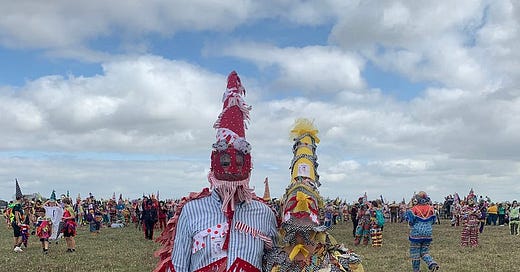



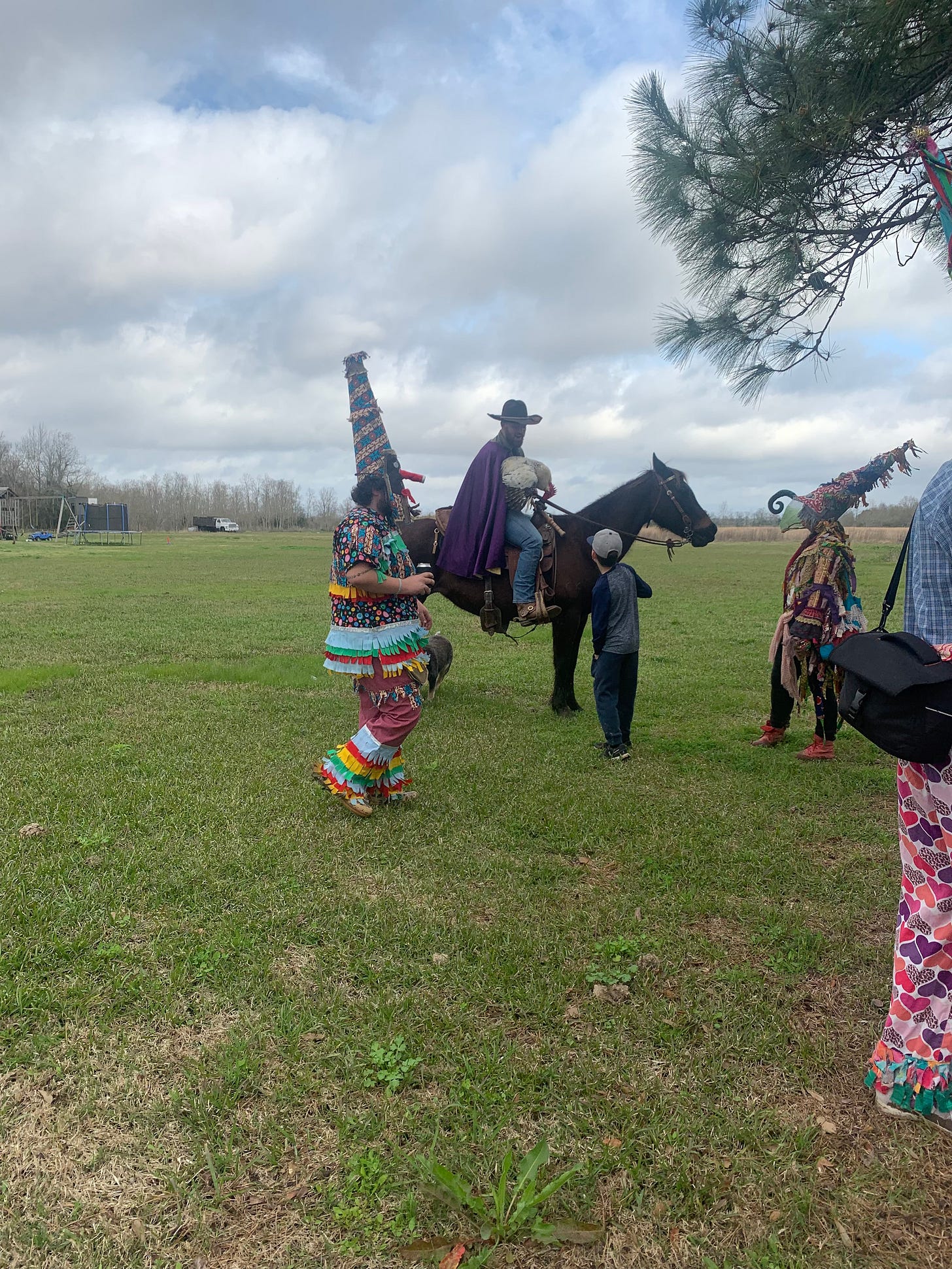
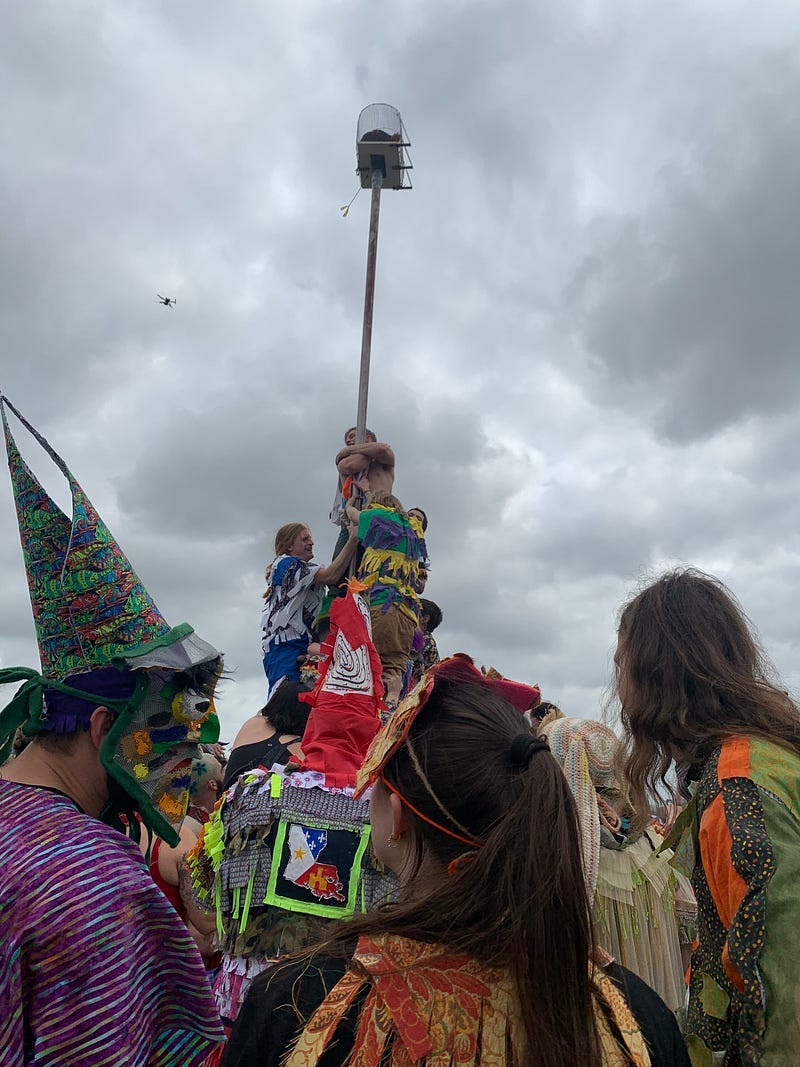
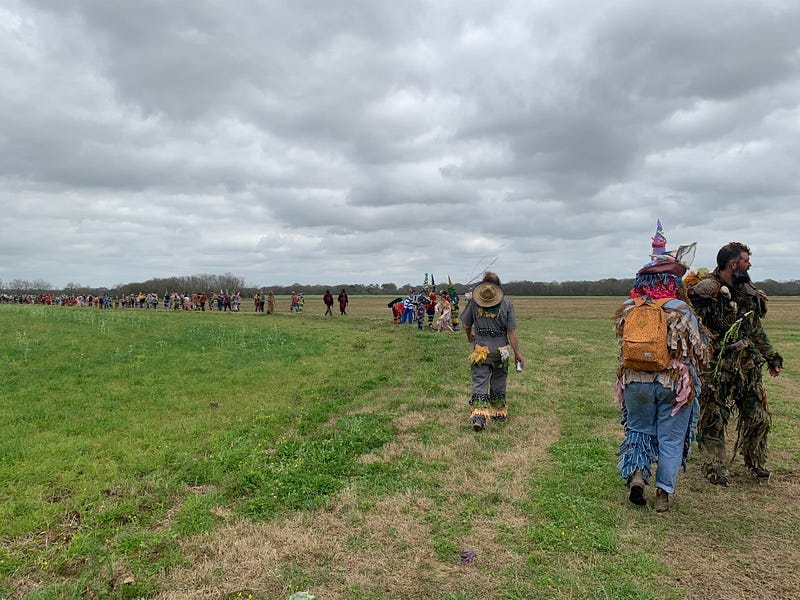
Sending well wishes for your surgery ❤️
oh those crazy cajuns . . . but i love their music and their jitterbug